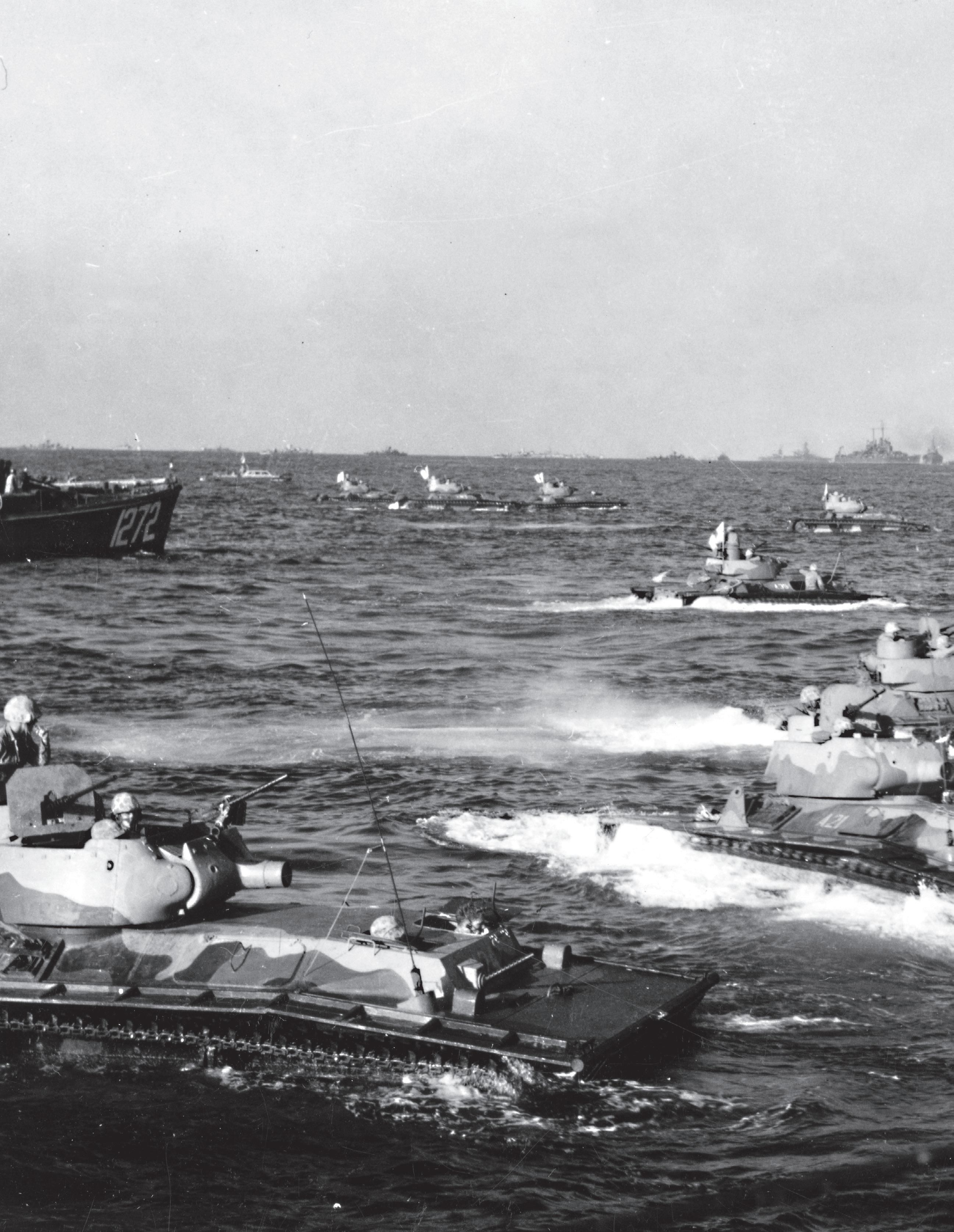
16 minute read
MARINE CORPS AMPHIBIOUS VEHICLES
ADDRESSING THE CHALLENGES OF YESTERDAY, TODAY, AND TOMORROW
BY SCOTT R. GOURLEY
Many written histories of U.S. Marine Corps amphibious vehicles proclaim an irony between the fact that they were invented to serve as life-saving platforms but have been primarily employed as amphibious assault vehicles. In reality, it is coincidence rather than irony since both current and future generations of these amphibious platforms continue a proud tradition of saving the lives of embarked and supported Marines in operations around the world.
In the mid-1930s, about the same time that the Marine Corps was concluding two of its so-called “Banana War” involvements – Haiti (1915-1934) and Nicaragua (second time, 1927-1934) – other amphibious service planners were looking toward possible future Marine Corps military actions and the equipment requirements necessary to support those actions.

LVT(A)-4s head for the Iwo Jima beach. The LVT(A)-4 was a specialist variant of the LVT based on the LVT-2, with added armor and an open-topped turret mounting a short-barreled 75mm howitzer to provide fire support on the beach.
U.S. MARINE CORPS HERITAGE CENTER PHOTO
Some of those investigations were focused on the potential applications of emerging tank designs in an amphibious environment. In fact, several countries were experimenting with concepts for amphibious tank designs, with many tank histories highlighting the early design work performed in England by Lt. Col. Philip Johnson. Like later models of Marine Corps amphibious assault vehicles, the early English models relied on the turning of the tracks to provide motion in the water.
In the United States, early amphibious vehicle experimentation utilized a self-propelled gun design developed by American inventor J. Walter Christie. As early as 1924, the Marine Expeditionary Force took a Christie amphibian tractor on winter maneuvers off Culebra, Puerto Rico, and in 1927 used six of them in China.
Although the Christie design was not adopted by the Marines, their experience with these vehicles contributed to the finding outlined in the Tentative Manual for Landing Operations of 1934: “The difficulties of transport and movement from ship-to-shore indicate that only light tanks can be used in the landing operation. These may be land tanks or amphibious tanks.”
In another historic coincidence, what would become the precursor to those “amphibious tanks” was being built in Florida at about the same time that manual was being printed.
Originally envisioned as a “mercy machine,” that first amphibious tractor was the brainchild of Donald Roebling, who was the son of financier John A. Roebling and grandson of Col. Washington Roebling, who built New York’s Brooklyn Bridge.
After moving to Clearwater, Florida, Donald Roebling had witnessed the impact of several devastating hurricanes, including the tragedies surrounding hurricane victims trapped in the then-impenetrable reaches of the Okeechobee area of the state. As he described it in later years, his vision focused on a vehicle that “would bridge the gap between where a boat grounded and a car flooded out.”
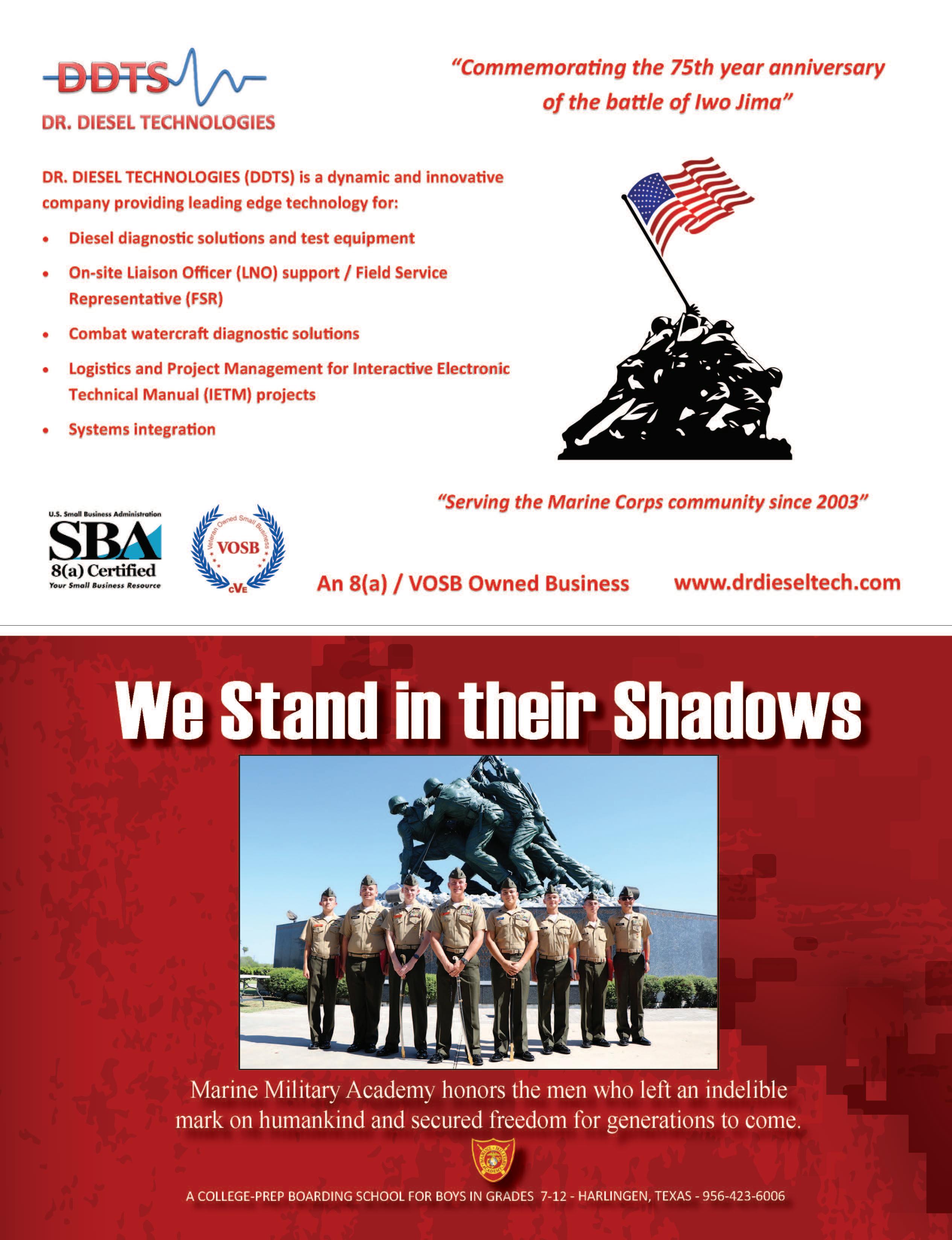
With funding from his father, Roebling began building a prototype of this rescue machine, now dubbed “Alligator,” in his own workshop. Early prototype performance results led to a series of mobility and weight modifications, leading to a 1937 model amphibious vehicle that had a weight of 8,700 pounds, land speed of 18 - 20 mph and water speed of 8.6 mph.
It was a picture of this model that reportedly appeared in an October 1937 issue of LIFE magazine, and it was a copy of that magazine that caught the eye of Marine Corps leaders. Representatives of the Marine Corps’ Equipment Board visited Roebling in Clearwater and returned with a favorable report on the Alligator’s potential.
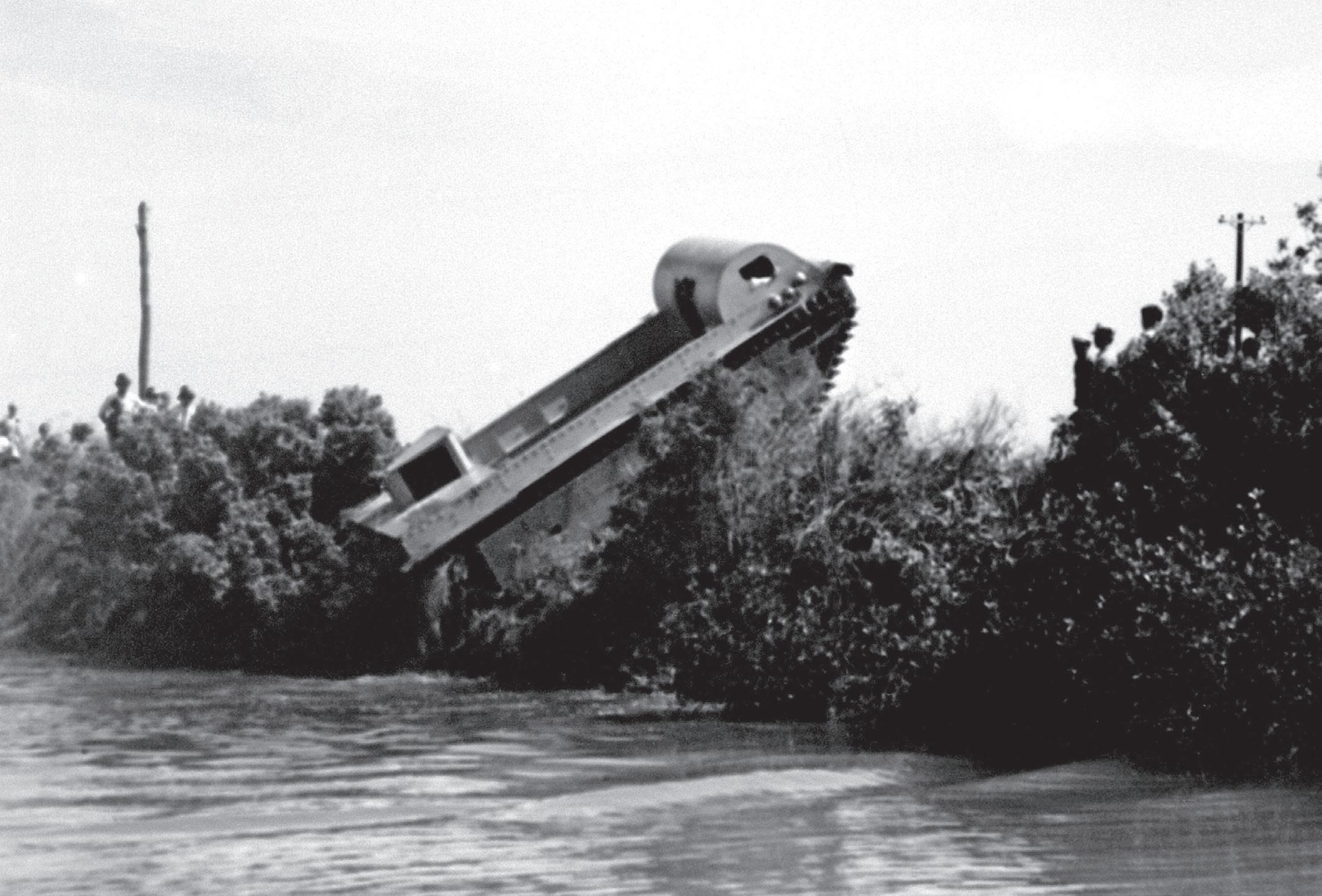
An early prototype Roebling “Alligator” tractor climbs ashore from the water. Donald Roebling originally developed the vehicle to rescue hurricane victims as well as serve other needs in marshy terrain.
NATIONAL ARCHIVES PHOTO
In May 1938, the Commandant of the Marine Corps recommended that a process be undertaken to obtain a prototype of the vehicle for further testing during upcoming military exercises. By May 1940, Roebling had completed the newest prototype design, an amphibious craft that was 20 feet long, 8 feet wide, and weighed 7,700 pounds. A second similar craft, measuring 20 feet long by 9 feet 10 inches wide, was delivered to the Marines in November and performed extremely well in testing during late 1940 and early 1941.
In an anecdotal story that appeared later in local papers, Roebling related that he had been questioned by the military about how he arrived at the width of the final prototype design. After reminding the questioner that the prototypes had been built in his home workshop, he pointed to the fact that his workshop doors and entrance gate were both 10 feet wide.
Regardless of the validity of that particular design criterion, in July 1941, after shifting from the prototype’s aluminum construction to an all-steel design, the first original model Landing Vehicle, Tracked (LVT-1) came off the Dunedin, Florida production line of Food Machinery Corporation (later FMC Corporation).
The LVTs would be known by many names, with the earliest designs dubbed “Alligators” and later models bestowed names ranging from “Water Buffaloes” to “Bushmasters.”
The December 1941 attack on Pearl Harbor forced recognition of the acute need for LVT capabilities, prompting a “freeze” in the LVT-1 design in order to get the vehicle into mass production. Contracts were soon let to multiple companies – including Food Machinery Corporation, Borg-Warner Corporation, Graham-Paige Motors Corporation, and St. Louis Car Company - for Navy and Marine Corps amphibious tractors, with U.S. Army orders following in April 1942.
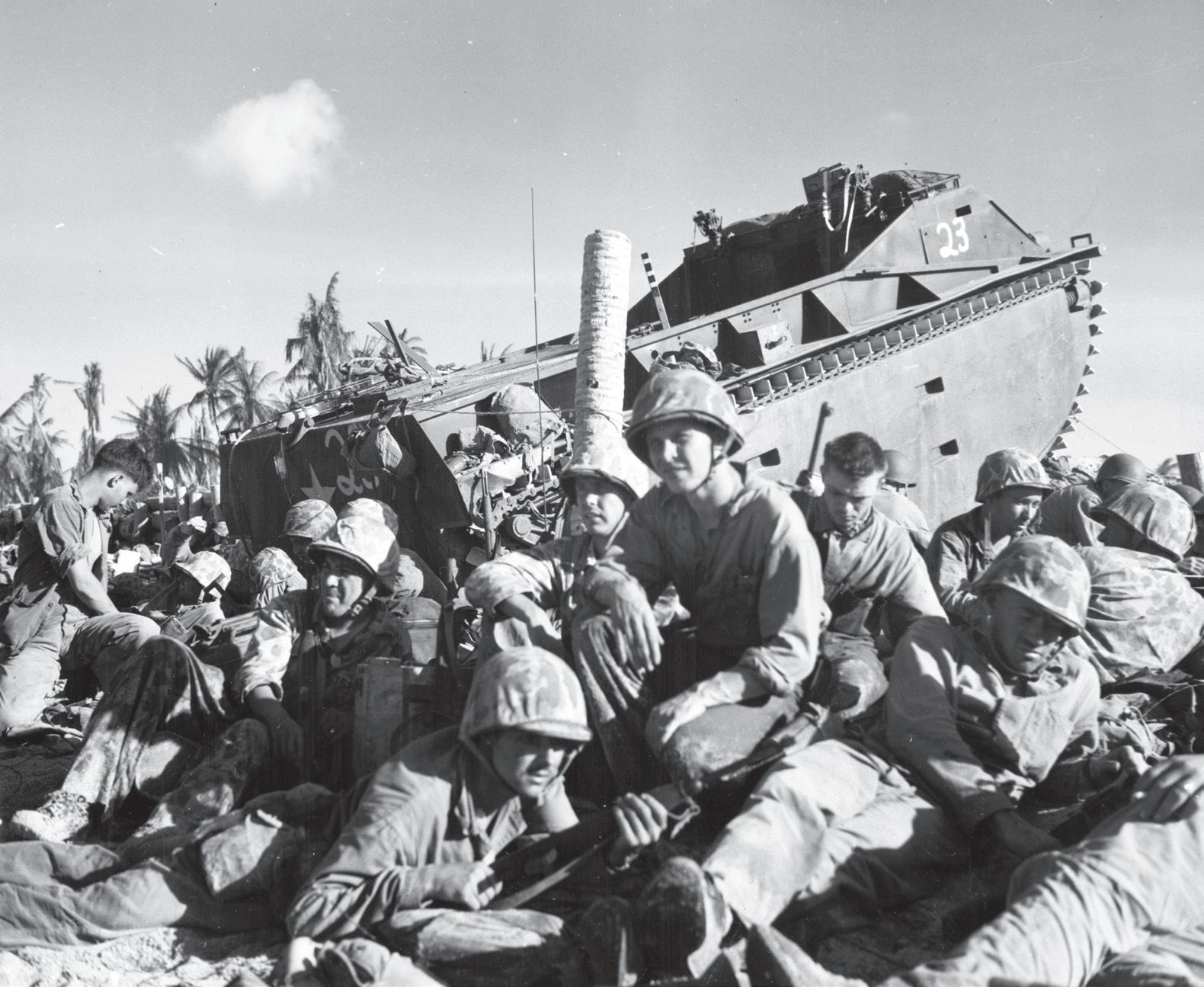
Marines take a break to rest beside an LVT on the beach at Tarawa. A low tide at H-hour meant that 125 LVTs became the only reliable way to transport groups of Marines back and forth to the beach. While the unarmored LVTs took heavy casualties, without them the landings on Tarawa might well have been beaten back.
U.S. MARINE CORPS PHOTO
According to the Dec. 1, 1945 “History of Landing Vehicle, Tracked,” prepared for the Secretary of the Navy, “While the LVT(1) was still being built, representatives of the Bureau of Ships began working with Roebling and Food Machinery engineers on an armored amphibian, resulting in the pilot model LVT(2) in October 1941. The importance of the Landing Vehicle, Tracked soon became apparent, and in November 1941, at their own expense, Borg-Warner Corporation submitted the first model ‘A’ forerunner of the turreted vehicles.”
Borg-Warner’s turreted A model design incorporated a light tank turret with 37 mm cannon as well as two bow machine guns, setting the stage for A model amphibious tanks to accompany the more utilitarian amphibious tractors.
In December 1941, Roebling completed designs for the LVT(A)-1 and in June 1942 the pilot model (A)-1 came off the line at Food Machinery’s plant in Riverside, California.
“However, development work did not cease, and in August 1942 Borg-Warner’s model ‘A’ and Food Machinery’s LVT(2) satisfactorily met the Bureau of Ships requirements in trials at Banana River, Florida,” according to the official history. “In January 1943 integral armor became a part of the LVT(2)s, and with the success of the trials, went into production in April as the LVT(A) (2). The same month Borg-Warner developed the model ‘B’ tractor, the first ramptype, which was tested at Camp Pendleton four months later. While the vehicle was not accepted, the subsequent model ‘D,’ a similar vehicle, was put through the course at Camp Pendleton in April of the next year, accepted, and renamed the LVT(3). Meanwhile, Food Machinery engineers were also at work on a tractor with ramp, and in August 1943 produced the pilot model LVT(4) in their Riverside plant… After surf tests the following month at Camp Pendleton, the vehicle went into production in December to fill the vital need in the Pacific for amphibians. Further trials were held in January [1944], and subsequent modifications later incorporated as a result of these tests.”
That early 1944 test and modification process led to the LVT(A)-4. Featuring an M8 howitzer motor carriage turret and multiple supplementary machine gun mounts, the LVT(A)-4 represented the most heavily armed and armored model of LVT produced to that time. The design would be later modified in April 1945 through the incorporation of a gyro stabilizer and power traverse of the turret. The resulting model became known as the LVT(A)-5.
According to official Coast Guard historical summaries, the Feb. 19, 1945 D-day operations at Iwo Jima featured an established line of departure 4,000 yards off the southeast beaches, with the first five assault waves being comprised only of LVTs. The first wave, consisting of 68 turreted A model vehicles, reached the beach at 0900, with the next four waves following within 23 minutes.
While the realities of the beach geology, topography, hydrology, and enemy artillery seriously limited the LVT’s onshore mobility, they did open the way for the follow-on arrival of the critical tank assets that freed the LVTs to perform combat support functions for which they were better suited.
As demonstrated on Iwo Jima, the LVTs were not without their vulnerabilities. Some of those vulnerabilities were clearly demonstrated five weeks after the Iwo Jima landings, on March 26, 1945, when the U.S. Army’s “Americal” Division conducted landings in the southern Philippines near Cebu City. The elaborately mined landing beach destroyed 10 of the first 15 LVTs to move ashore.
While these types of wartime experiences trended toward heavier and heavier vehicles, other service visionaries also realized that heavier is not always better. Consequently, in June 1945, just a few months after the landings on Iwo Jima, service representatives witnessed a demonstration of new lightweight LVT designs from both Food Machinery Corporation and Borg-Warner at Camp Pendleton, California.
Counting these lightweight prototypes (two from each company), the Secretary of the Navy’s 1945 history indicates that a total of 18,620 LVTs of all types were produced during World War II. The history lists Iwo Jima as one of 34 major World War II amphibious operations in which LVTs were used. The complete listing includes:
• Guadalcanal, Solomons (Aug. 7, 1942) • French Morocco, Africa (Nov. 8, 1942) • Attu, Aleutians (May 11, 1943) • Shemya, Aleutians (Aug. 15, 1943) • Rendova, New Georgia (Solomons) (Sept. 1, 1943) • Bougainville, N. Solomons (Nov. 1, 1943) • Tarawa, Gilberts (Nov. 20, 1943) • Makin, Gilberts (Nov. 21, 1943) • Arawe, New Britain (Dec. 15, 1943) • Cape Gloucester, New Britain (Dec. 26, 1943) • Kwajelein, Marshalls (Feb. 1, 1944) • Namur, Marshalls (Feb. 3, 1944) • Roi, Marshalls (Feb. 3, 1944) • Eniwetok, Marshalls (Feb. 17, 1944) • Emirau, Admiralties (March 20, 1944) • Hollandia, New Guinea (April 22, 1944) • Biak, New Guinea (May 27, 1944) • Saipan, Marianas ( June 14, 1944) • Noemfoor, New Guinea ( July 2, 1944) • Guam, Marianas ( July 21, 1944) • Tinian, Marianas ( July 24, 1944) • Cape Sansapor, New Guinea ( July 30, 1944) • Peleliu, Palau, Carolines (Sept. 15, 1944) • Morotai, New Guinea (Sept. 15, 1944) • Angaur Island, Palau (Sept. 17, 1944) • Scheldt Estuary (Oct. 6, 1944) • Leyte (Oct. 20, 1944) • Belgium (Nov. 8, 1944) • Lingayen Gulf, Luzon ( Jan. 9, 1945) • Iwo Jima (Feb. 19, 1945) • Philippines (Feb. 28, 1945) • Rhine Crossing (March 7, 1945) • Okinawa (April 1, 1945) • Balikpapan, Borneo ( July 1, 1945)
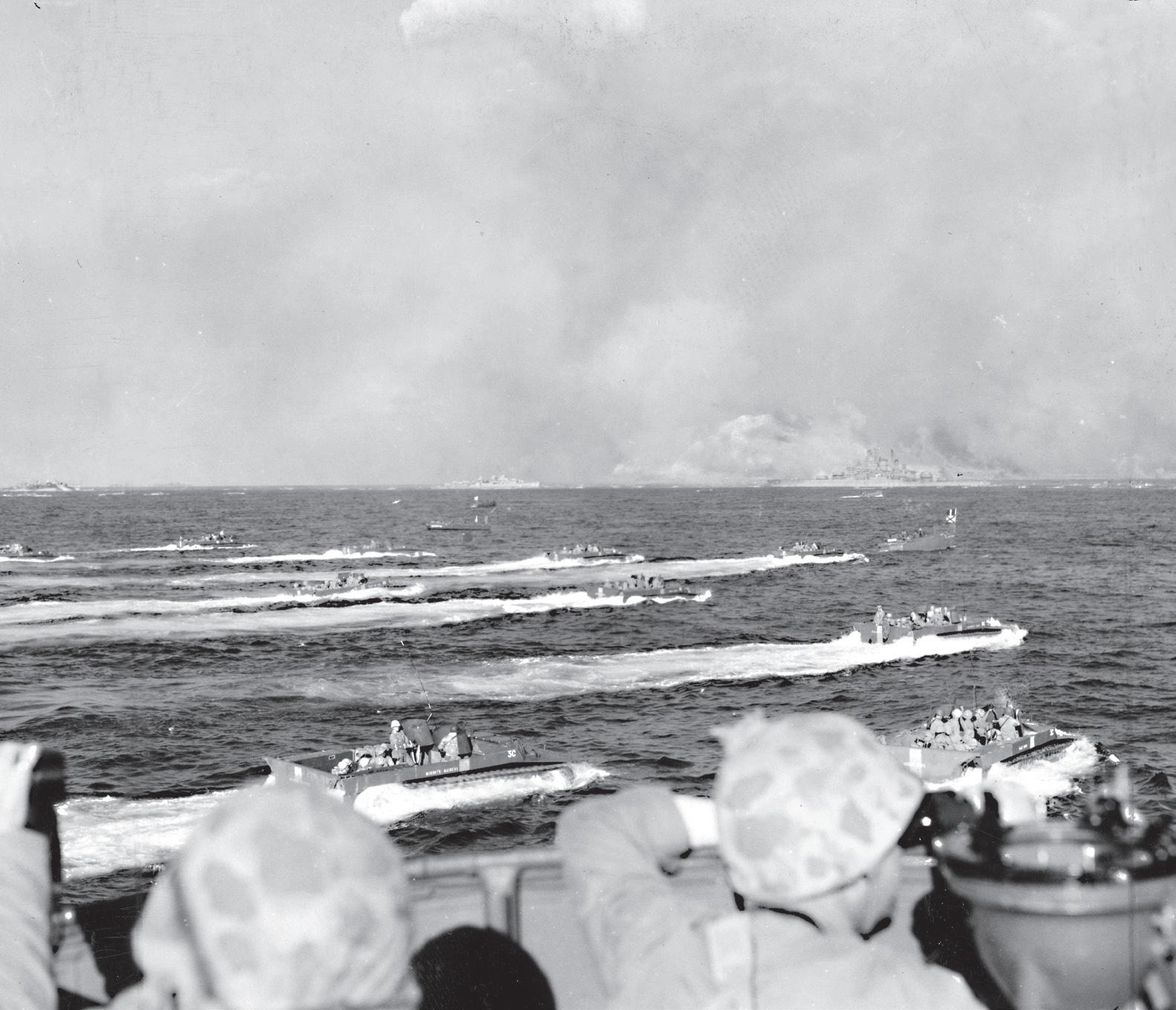
LVTs carry Marines toward Iwo Jima on D-day.
NATIONAL ARCHIVES PHOTO
According to the wartime history, “While production continued through 1944 on all types except the LVT(1), reports poured in from every theater of the war, praising the vehicle’s performance. ‘LVTs, probably more than any other single piece of equipment, contributed to the success of the campaign.’ ‘This operation would have been impossible without the LVTs.’ ‘LVTs are our most versatile craft.’ ‘The men in the field soon came to look on the tractors as the ‘jack of all trades.’ In addition to their early military use as troop carriers and artillery support, LVTs were utilized as command posts, supply vehicles, for aircraft salvage and shallow-water minesweeping. As tho’ never forgetting their origin, LVTs fulfilled their inventor’s purpose by evacuating wounded, carrying medical supplies to the front, and even serving as mobile hospitals for emergency operations.”
While recognized for their extreme versatility, the immediate post-war period witnessed the cancellation of remaining production contracts and a retrenchment of service capabilities that saw the Army withdraw from the amphibious tank/amphibious tractor arena.
For their part, the Marines focused their post-war capabilities on their newest model production vehicles: LVT-3 and LVT(A)-5.
With wartime experiences still fresh, the post-war years saw a significant number of LVT-3 vehicles “upgraded” with the addition of armor protection for the troop bays. It was many of these vehicles, redesignated as LVT-3C, that were used in conjunction with LVT(A)-5 amphibious tanks, during the Korean War Inchon landings.
Although very low levels of technology prototype activity had taken place in the years between World War II and the Korean War, the Korean experience prompted the Navy to proceed with the development of new LVT designs. Plans called for these new vehicles to include a basic personnel carrier model (LVTP-5) with specific variants tailored to command (LVTC-5), recovery (LVTR-1), fire support (LVTH-6), and other tactical missions.
The LVTP-5 vehicle was larger than the LVT-3C that it replaced (29 feet 8 inches long by 11 feet 8.5 inches wide for the LVTP-5 versus 25 feet 1.5 inches long by 11 feet 2.5 inches wide for the LVT-3C. Initial deployment of these vehicles took place in 1956, with subsequent mobility enhancements expanding the identification on some vehicles with an additional “A1” designator.
Both LVTP-5 and LVTH-6 series (which incorporated a 105 mm howitzer for both direct and indirect fire support) saw employment during the Vietnam War. The lessons learned from the combat employment of these systems fed into Marine Corps investigations of design concepts for a new LVT.
In 1966, FMC Corporation received a contract to design, develop, and fabricate approximately one dozen of these new vehicles, tentatively designated as LVTPX12s. Incorporating twin hydrojet engines for enhanced water propulsion, the “PX-12s” measured 26 feet by 10.5 feet. Prototype deliveries and testing ran from late 1967 through 1969.
The vehicle family, soon renamed LVT-7, consisted of three configurations: the primary model LVTP-7 (Personnel); LVTC-7 (Command and Control); and LVTR-7 (Recovery). In 1970 FMC received an initial multiyear production contract for the LVT-7 series with initial deliveries beginning in late 1971.
The new vehicles were hailed during the formal acceptance ceremonies held on Aug. 26, 1971, when Rear Adm. Nathan Sonenshein, Commander, Naval Sea Systems Command, observed that “…the LVTP7 family of vehicles is superior in every respect to all its predecessors. They will be faster and more maneuverable on land and in the water, lighter in weight, more reliable and more easily maintained; moreover, they will have improved firepower and a reduced price tag …”
While these features and capabilities provided the LVTP-7s with greater tactical flexibility than their predecessor LVTP-5s, evolving Marine Corps strategies envisioned an amphibious assault capability that would be better suited for land combat. The result was a notional LVT(X) exploration effort that examined the development of a potential fighting vehicle design that resembled a cross between an LVT and a Bradley Fighting Vehicle. Although several companies began development of concepts the program was terminated for a variety of reasons before prototypes were completed.
Meanwhile, the demonstrated durability of the LVT7 series led to a Service Life Extension Program (SLEP) that saw a combination of vehicle conversions and new production of a fleet of LVTP-7A1s, LVTC7A1s and LVTR-7A1s.
In 1985, at about the same time as the final deliveries of the A1 series, the Marine Corps changed the designation of the series from Landing Vehicle, Tracked to Amphibious Assault Vehicle (AAV), a name change that signified the expanded roles and missions inherent in amphibious operations.

Marines assigned to the 3rd Assault Amphibious Battalion, 1st Marine Division conduct a mobile beachhead patrol in an AAV7A1 during Exercise Iron Fist 2018. The Marine Corps is planning to replace the AAV7A1 with the ACV.
U.S. MARINE CORPS PHOTO BY CPL. JACOB A. FARBO
The A1 SLEP was seen by planners as a way to extend the utility of the AAV7s “into the 1990s.” However, it would be these same basic platforms in early 2003 that would help conduct the longest sequence of coordinated overland attacks in Marine Corps history.
According to the 1st Marine Expeditionary Force summary of action, “From crossing the Line of Departure (LOD) on the border between Kuwait and Iraq, to the culmination of hostilities well north of Baghdad, the Division covered 808 kilometers in 17 days of sustained combat.”
Meanwhile, amphibious service planners and industry designers were hard at work, developing a replacement for the Marine Corps’ aging AAV7A1 series of assault amphibians.
The initial vision for that replacement was reflected in the Advanced Amphibious Assault Vehicle (AAAV) program. In July 2001, the program moved into its System Development and Demonstration (SDD) phase with a Marine Corps contract awarded to General Dynamics Land Systems.
Renamed as the Expeditionary Fighting Vehicle (EFV) in 2003, the program represented the Marine Corps’ No. 1 priority ground weapon system acquisition program as well as the only ACAT 1D program managed by the Marine Corps.
Service descriptions noted that the EFV would provide the capability to maneuver, combat loaded, with a Marine rifle squad at 20-25 knots in the water and maneuver cross country with agility and mobility equal to or greater than that of the M1 tank – capabilities that would allow the Navy and Marine Corps “to link maneuver in ships and maneuver ashore in all types of amphibious operations, and will provide a new capability in support of Expeditionary Maneuver Warfare.”
The Department of Defense restructured the program in June 2007 and awarded a follow-on development contract in July 2008, focusing on redesigning some of the key EFV subsystems to improve reliability. In July 2010, the Marine Corps received the first prototypes of the redesigned SDD-2 EFV, paving the way for the start of government developmental testing at the Marine Corps’ Amphibious Vehicle Test Branch, Camp Pendleton, California.
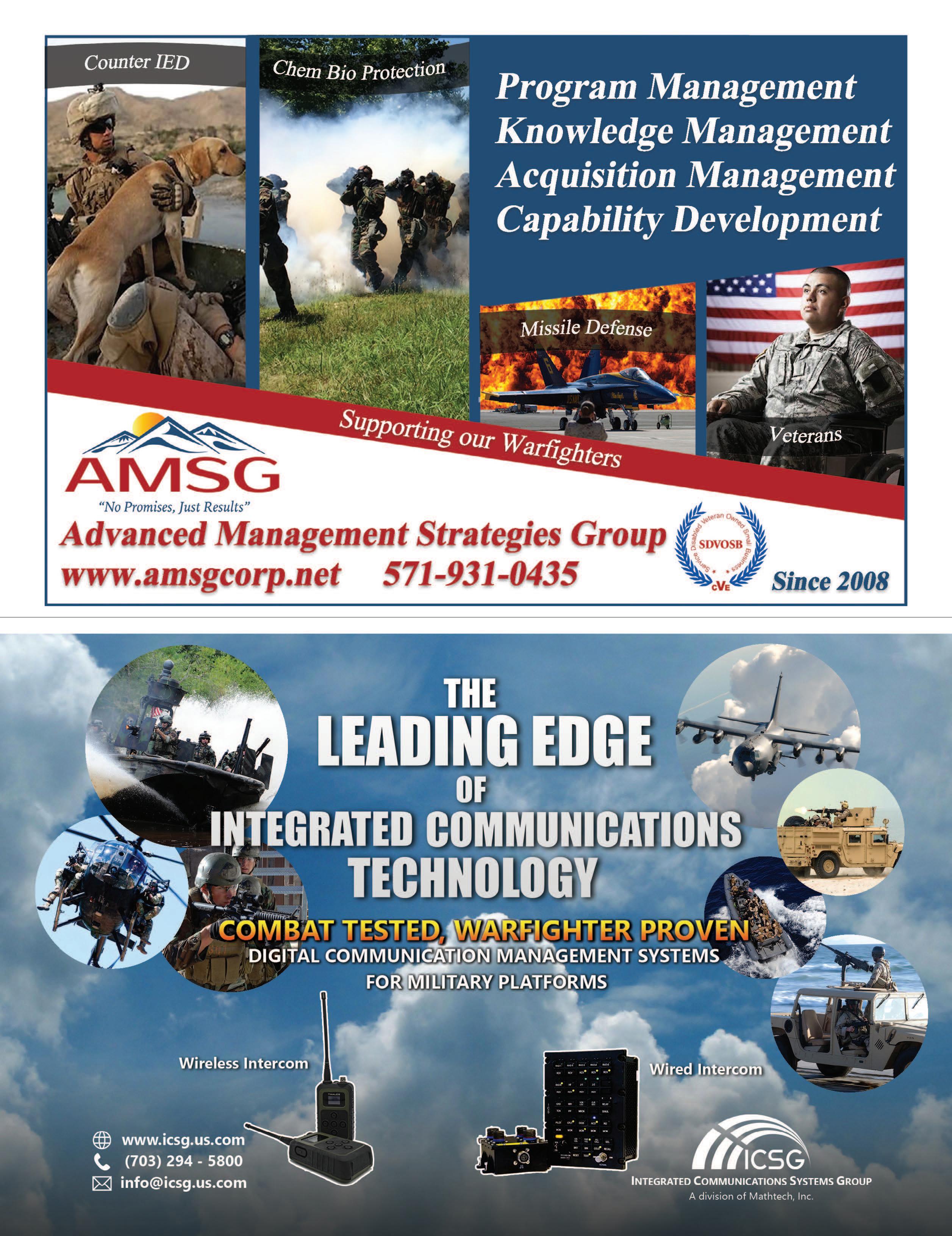
The SDD-2 prototypes delivered to Camp Pendleton incorporated more than 200 design changes from earlier models, with many of those changes focused on enhancing vehicle performance and reliability.
At the time of the prototype deliveries, the Marine Corps had an Approved Acquisition Objective (AAO) of 573 EFVs with Initial Operational Capability (IOC) in 2016 and Full Operational Capability (FOC) in 2026.
Service representatives also pointed to the myriad changes incorporated in the SDD-2 prototypes, characterizing them as “extremely significant” and calling for a “new perspective” on the EFV program.
However, on Jan. 6, 2011, Defense Secretary Robert Gates announced termination of the EFV program, with the Marine Corps turning its focus instead to the rapid development of a “more affordable and sustainable” replacement for the EFV.
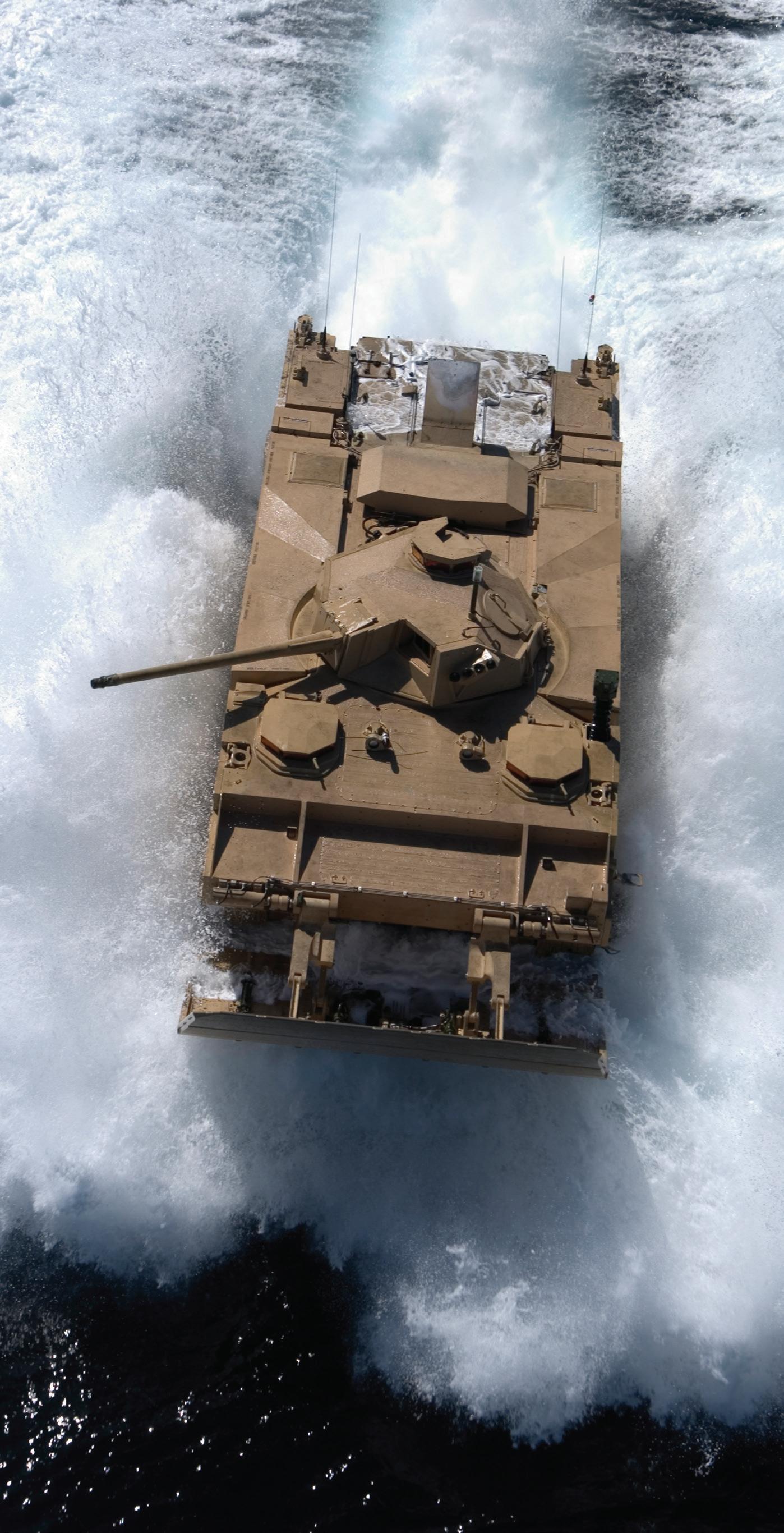
The Expeditionary Fighting Vehicle (EFV) offered exceptional speed, mobility, and lethality on land and water, but after delays and difficulties with the program it was canceled in 2011.
U.S. MARINE CORPS PHOTO
The notional replacement effort featured an Amphibious Combat Vehicle (ACV), which would incorporate some EFV amphibious capabilities, as well as a Marine Personnel Carrier (MPC), which would serve as a survivable platform to transport Marines once ashore. Although MPC was put “on hold” over budgetary concerns in June 2013, it was “resurrected” in March 2014 and redesignated as ACV Increment 1.1. The plan announced at the time was to acquire approximately 200 ACV 1.1s, and then follow with the acquisition of approximately 470 ACV 1.2 variants, with the 1.2 vehicles featuring greater amphibious capabilities.
In late November 2015, the Marine Corps awarded BAE Systems and SAIC contracts to develop ACV 1.1 prototypes, with those prototypes delivered for testing early in 2017.
In June 2018, the Marine Corps selected BAE Systems, along with teammate Iveco Defence Vehicles, to produce the ACV 1.1 and awarded the low rate initial production contract for the personnel variant.
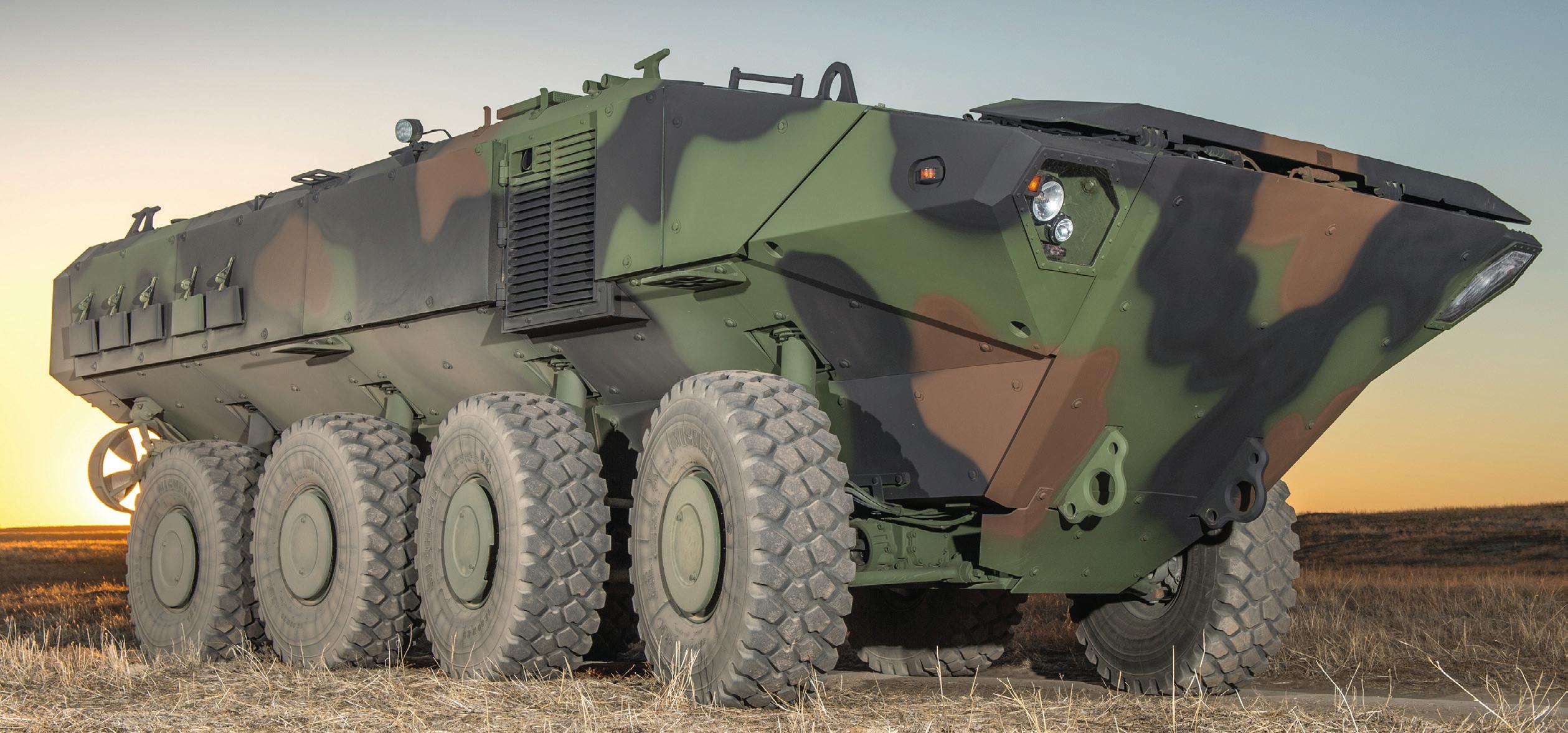
The Marine Corps’ next-generation amphibious assault vehicle will be the eightwheeled Amphibious Combat Vehicle (ACV), now planned to include three different variants.
BAE SYSTEMS PHOTO
Less than a year after that award, service leadership testimony before the Senate Armed Services Committee in April 2019 acknowledged that ACV 1.1 prototype testing in the fall of 2018 had actually met the amphibious mobility requirements envisioned for ACV 1.2. As a result, the formerly separate programs were consolidated into a single ACV family of vehicles intended to replace all AAVs.
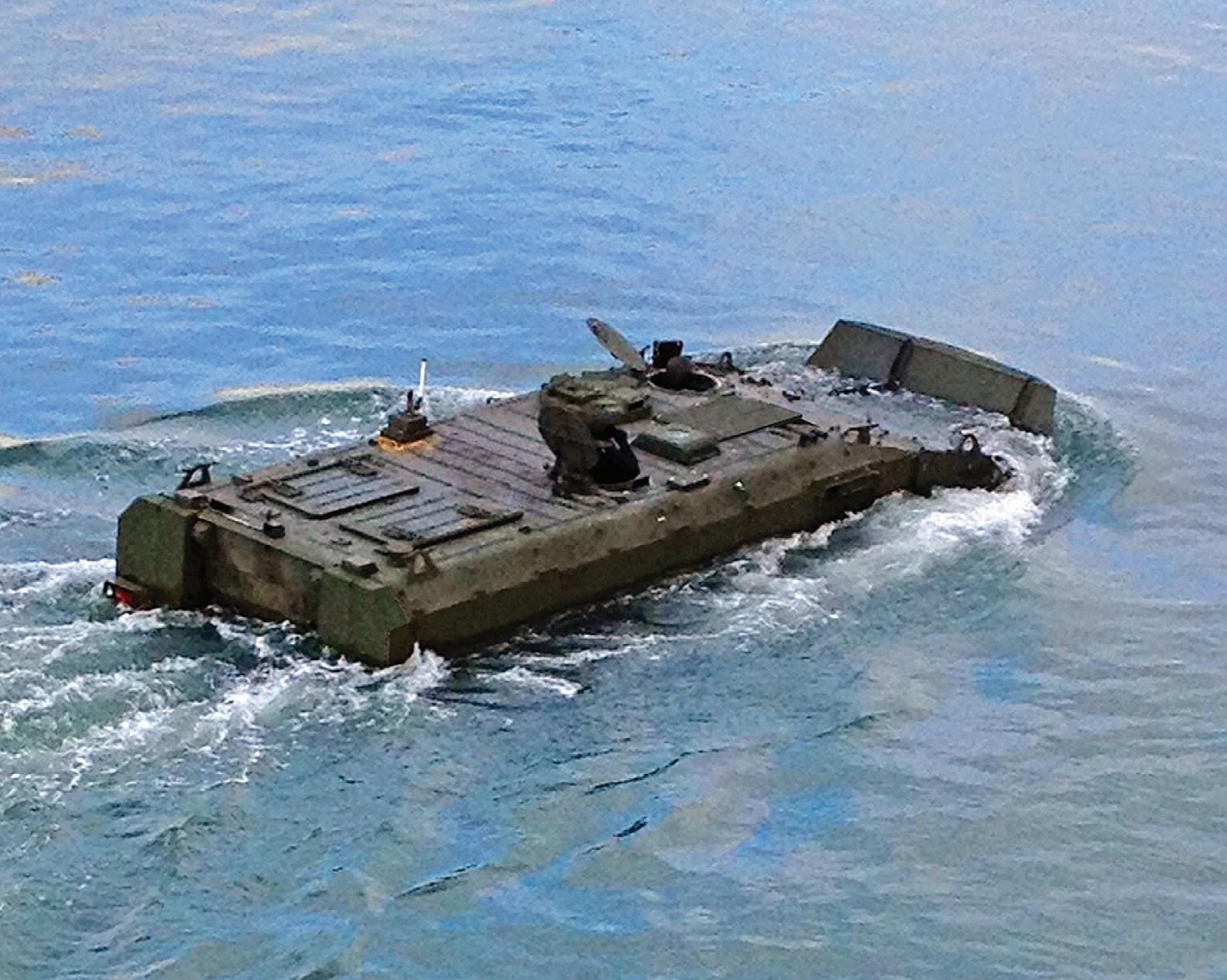
BAE SYSTEMS PHOTO
Just two months later, BAE Systems and Iveco Defence Vehicles announced receipt of a contract modification to develop two new ACV designs to support the ACV Personnel (ACV-P) variant.
The new contract modification calls for the design and development of new command (ACV-C) and 30mm medium caliber cannon (ACV-30) variants. Developers note that the ACV-C incorporates seven work stations to provide situational awareness and control of the battle space, while the ACV-30 integrates a 30mm cannon to provide the lethality and protection the Marines need while leaving ample room for troop capacity and payload.
It’s a long way from Donald Roebling’s garage.










